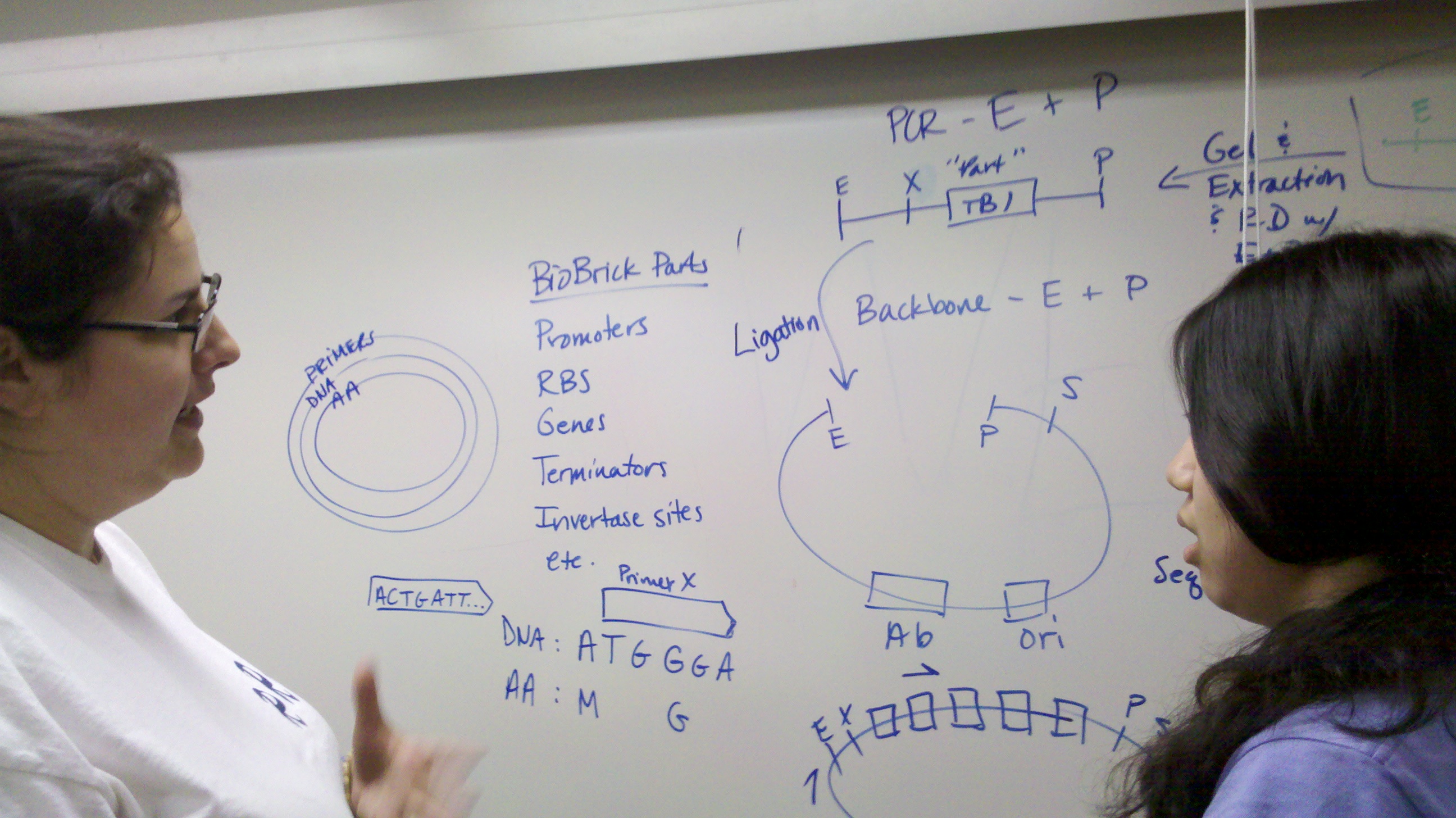Team:BU Wellesley Software/Methodology
From 2011.igem.org
(Difference between revisions)
| (9 intermediate revisions not shown) | |||
| Line 90: | Line 90: | ||
JUMP TO...<br> | JUMP TO...<br> | ||
<a href="#bu-wellesley_wiki_content">Top</a><br> | <a href="#bu-wellesley_wiki_content">Top</a><br> | ||
| - | <a href="#overview"> | + | <a href="#overview">Overview</a><br> |
<a href="#process">Design Process</a><br> | <a href="#process">Design Process</a><br> | ||
</div> | </div> | ||
<div id="overview"> | <div id="overview"> | ||
| - | <h1> | + | <h1>Overview</h1> |
<p> | <p> | ||
In our project, we applied a user-centered design (UCD) approach for developing software tools for synthetic biology. In UCD, users are involved throughout all stages of the design process. Thus, extensive attention is given to gather information about users, identify their needs, and to test and refine designs based on users’ feedback. The main goal of UCD is to develop software tools that users find desirable, usable, and useful. Tools that rather than forcing users to adopt their behavior, improve and enhance current practices. | In our project, we applied a user-centered design (UCD) approach for developing software tools for synthetic biology. In UCD, users are involved throughout all stages of the design process. Thus, extensive attention is given to gather information about users, identify their needs, and to test and refine designs based on users’ feedback. The main goal of UCD is to develop software tools that users find desirable, usable, and useful. Tools that rather than forcing users to adopt their behavior, improve and enhance current practices. | ||
| Line 105: | Line 105: | ||
<p> | <p> | ||
Our design process consisted of an iterative cycle that included 4 stages: | Our design process consisted of an iterative cycle that included 4 stages: | ||
| - | << | + | |
| + | <center><img src="http://cs.wellesley.edu/~hcilab/iGEM_wiki/images/designcyce.jpg"></center> | ||
| + | <br><br> | ||
Following, we describe the key activities we employed in each stage: | Following, we describe the key activities we employed in each stage: | ||
| + | |||
| + | |||
<h2>Analysis</h2> | <h2>Analysis</h2> | ||
| Line 129: | Line 133: | ||
<ul> | <ul> | ||
<li>Brainstormed design concepts and metaphors | <li>Brainstormed design concepts and metaphors | ||
| - | <li>Developed walkthroughs of design concepts | + | <li>Developed <a href="https://2011.igem.org/Team:BU_Wellesley_Software/eLabNotebook#results">walkthroughs</a> of design concepts |
<li>Created design sketches | <li>Created design sketches | ||
| - | <li>Created low-fidelity prototypes < | + | <li>Created <a href="http://www.youtube.com/watch?v=Q8_uj_YLyiM">low-fidelity prototypes</a> (see example below) |
<li>Conducted usability testing on low-fidelity prototypes | <li>Conducted usability testing on low-fidelity prototypes | ||
<li>Created high-fidelity detailed design | <li>Created high-fidelity detailed design | ||
<li>Did usability testing again | <li>Did usability testing again | ||
</ul> | </ul> | ||
| - | + | <br> | |
| + | <center><iframe width="560" height="315" src="http://www.youtube.com/embed/Q8_uj_YLyiM" frameborder="0" allowfullscreen></iframe></center> | ||
| + | <br> | ||
<h2>Implementation</h2> | <h2>Implementation</h2> | ||
<ul> | <ul> | ||
| Line 148: | Line 154: | ||
<h2>Evaluation</h2> | <h2>Evaluation</h2> | ||
<ul> | <ul> | ||
| - | <li>Evaluated the usability and usefulness of our software tools by deploying them for use by our wet lab team < | + | <li>Evaluated the usability and usefulness of our software tools by deploying them for use by our |
| + | <a href="https://2011.igem.org/Team:BU_Wellesley_Software/Wet_Lab#tools">wet lab team</a> | ||
<li>Considered various quantitative measures (e.g. time on task, subjective satisfaction) and qualitative indicators (e.g. collaboration and problem solving styles demonstrated by users) | <li>Considered various quantitative measures (e.g. time on task, subjective satisfaction) and qualitative indicators (e.g. collaboration and problem solving styles demonstrated by users) | ||
</ul> | </ul> | ||
Latest revision as of 21:53, 28 September 2011
Methodology
Overview
In our project, we applied a user-centered design (UCD) approach for developing software tools for synthetic biology. In UCD, users are involved throughout all stages of the design process. Thus, extensive attention is given to gather information about users, identify their needs, and to test and refine designs based on users’ feedback. The main goal of UCD is to develop software tools that users find desirable, usable, and useful. Tools that rather than forcing users to adopt their behavior, improve and enhance current practices.
Design Process
Our design process consisted of an iterative cycle that included 4 stages:

Following, we describe the key activities we employed in each stage:
Analysis
- Observed users in the lab: our own wet-lab team, and the MIT iGEM team.
- Met with a wide variety of users to understand their needs, requirements, and constraints. We conducted focus groups and interviews with: PIs from the Harvard Medical School, researchers from the Weiss Institute, Boston University, and MIT, Biology faculty from MIT and Wellesley College, the MIT iGEM team.
- Looked at competitive products
- Created user profiles
- Developed a task analysis
- Documented user scenarios
Design



- Brainstormed design concepts and metaphors
- Developed walkthroughs of design concepts
- Created design sketches
- Created low-fidelity prototypes (see example below)
- Conducted usability testing on low-fidelity prototypes
- Created high-fidelity detailed design
- Did usability testing again
Implementation
- Conducted ongoing heuristic evaluations
- Iterated on visual design, performance, and
- Conducted on going usability testing with users (our wet-lab team, biology students and faculty)
Evaluation
- Evaluated the usability and usefulness of our software tools by deploying them for use by our wet lab team
- Considered various quantitative measures (e.g. time on task, subjective satisfaction) and qualitative indicators (e.g. collaboration and problem solving styles demonstrated by users)
 "
"
